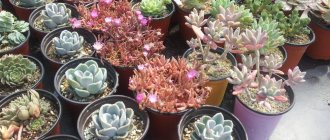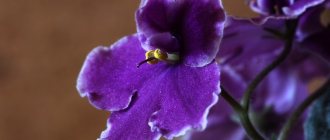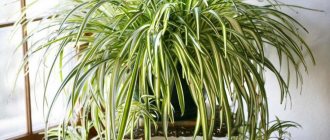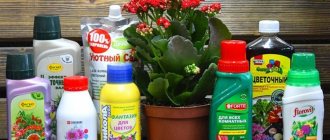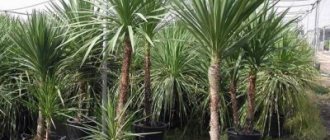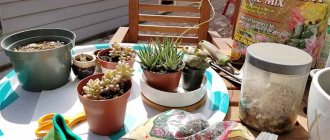Succulents are often called "hardy plants." Indeed, they have low maintenance requirements and are easy to grow - making them ideal potted flowers for beginners. Succulents will thrive where many other plants die: in dry, hot and sunny places (for example, on south-facing windowsills). The biggest mistake we can make when caring for succulents is... watering too often and too much.
How to properly care for succulents? How to water them? What types of succulents (and cacti) would work best in our apartment?
Names, photos and distinctive features of flowers similar to cacti
An unusual plant with thorns instead of leaves can be found in almost every home. Many exotic plants are related to or closely resemble cacti, including the huge family of succulents.
It is sometimes difficult for an inexperienced gardener to distinguish a cactus from another flower. In this article we will tell you the names of plants that resemble cacti in their appearance.
What you need to know about succulents
Lighting conditions
Light is the most important factor to consider when choosing the right succulents for your space. Most do well in bright, full sun (they are desert plants, after all), so unless you plan on placing your babies on a sunny windowsill or outdoors that gets a lot of sunlight, be sure to choose succulents that will suit . good in low light. You can also purchase grow lights for succulents and other plants to help them stay happy during the darker winter months.
Color and size
Succulents come in a variety of colors, from dusty sage to vibrant purple, and some grow taller than others. If you're planting a succulent container garden, try to get a variety of different colors and heights so you can have fun deciding how to arrange them all together. Aloe and cacti can be beneficial for taller succulents, and they look great surrounded by little colorful people. Additionally, some succulents will change color themselves or even produce colorful flowers under the right conditions, so keep an eye out for varieties that do this.
Names and photos of plants resembling cacti
Agave
Agave is easy to identify by its appearance. Agave has large, fleshy, light green leaves, similar to aloe leaves with small spines along the edges. It blooms very rarely, the first time every 10-15 years. It can grow up to 12 meters.
Succulents store moisture in their leaves , but most cacti do not have them, so they store moisture in their stems. The most important distinguishing feature of cacti is the spines that grow from the areoles.
The agave plant is native to North America. Wild representatives of this exotic crop can be found in the desert, but there are also many indoor species of this plant. At home, agave has a variety of colors and low leaves no more than 60 cm long.
The unique culture does not require special care. It is enough to place your pet in a well-lit place, water it regularly and replant it once a year.
Read more about agave and prickly pear in this material.
Haworthia
Haworthia is a low herbaceous succulent plant. Native to South Africa, it has fleshy, tough leaves that are collected in a round rosette.
All types of haworthia have special, distinctive features:
- absence of a stem - foliage grows from a basal rosette;
- unsightly flowers of the same shape and short leaves no more than 5-10 cm in length.
Haworthia has an external resemblance to aloe and cactus. All these crops absorb moisture from the air.
In nature, Haworthia grows in arid areas - in the deserts and steppes of South Africa.
In countries with temperate climates, exotic crops can only be grown at home. Like all succulents, the plant is unpretentious. The southern heat-loving culture prefers shaded places instead of bright sun.
Heliocereus
Heliocereus is a bushy epiphytic plant native to Mexico. This is one of the most amazing representatives of the cactus family.
The hanging or erect stem in young plants is reddish-green , and in adults it is dark green. Heliocereus, like any other cactus, has spines - thin, long, yellow-brown.
Daytime heliocereus blooms during daylight hours. The long flowering period has made the plant decorative. After flowering, the plant is decorated with fruits - prickly, red, egg-shaped fruits.
At home, an unusual representative of cacti requires minimal care - good lighting with protection from direct sunlight, moderate watering during the growing season.
Spurge
Due to its resemblance to a branched cactus, milkweed is often considered one of these popular plants. On the ribs of the thick triangular stem, like most cacti, there are small straight spines and bright green oval-shaped leaves 3-5 cm.
An important distinguishing feature of milkweed is its high growth rate. If you don’t pinch the top, this amazing plant can grow to the ceiling.
It is by the presence of milky sap that one can distinguish spurge from any other plant. Euphorbia is especially often confused with a cactus. These outwardly similar plants differ in their flowers and thorns - in milkweed the thorns grow on a smooth surface, and in the cactus in the areoles.
This is a very unpretentious crop that is easy to grow. Euphorbia grows well in both full sun and partial shade. On summer days, abundant watering and fertilizing are required a couple of times a month.
A huge number of different types of milkweed are grown at home.
Aloe is a succulent whose fleshy leaves are collected in basal and apical rosettes with sharp teeth along the edge.
Aloe is often confused with a cactus, but these plants belong to different families with one important difference - aloe stores moisture in the leaves, and cactus stores moisture in the stem.
Cactus spines are modified leaves, and aloe spines are sharp growths on the leaves. The homelands of these crops are also different - cacti come from the deserts of America, Mexico, Cuba, and aloe comes from South Africa.
Aloe loves light and warmth and needs watering once a week. A very unpretentious creature. In nature it grows up to three meters in height. It is very easy to grow agave at home. The most popular indoor plant species:
Gasteria
Another nice representative of succulents, native to the deserts of South Africa, which is often confused with cacti - gasteria. The fleshy, tongue-shaped leaves of this plant have a pointed or rounded shape. Gasteria flowers look like bells due to their fused petals.
This is a small, slow growing succulent.
An unpretentious and pretty succulent is perfectly grown indoors and is ideal even for novice gardeners. The plant needs light and a minimum of moisture.
Stapelia
Native to Southwestern and Southern Africa, this perennial low-growing succulent has tetrahedral, fleshy shoots.
Stapelia is constantly confused with a cactus. The main similarity is the non-sharp teeth located on the edges of the stems. This type of succulent differs from its fellows in its delightful original flowering. Stapelia flowers are pubescent stars, which are formed on bent pedicels at the base of the shoots. A characteristic feature of all slipways is the rich and very bright, cool color of the greenery.
Despite its specific aroma, the plant is a very popular indoor plant. Caring for an unusual pet is not difficult. The main thing is to place the flower pot in a well-lit place. It is necessary to water rarely, but abundantly.
Echeveria
The heat-loving echeveria, native to Mexico, is often called the “stone rose.” This is a perennial whose oval leaves are collected in a beautiful rosette, very reminiscent of a rose. The plant has a bluish-gray color. The length of the leaf is approximately 15 centimeters, and the width of the leaf can grow up to 25 centimeters. In summer, echeveria can form small flowers that resemble bells - this is what distinguishes the plant from others.
Echeveria does not belong to the cactus family. Although both are succulent, fleshy plants. Sometimes the “stone rose” is confused with another similar plant - juvenilia. Frost-resistant juveniles can be grown in open ground on alpine hills, but echeveria does not tolerate sub-zero temperatures.
The perennial can often be found on window sills or greenhouse gardens . The unpretentious “stone rose” grows well at home and does not cause trouble to its owners. The main thing is to provide it with bright light and not to overdo it with watering.
Sansevieria
Sansevieria is a succulent belonging to the Agave family. For its hard, striped and long leaves, the plant was popularly called “pike tail” and “mother-in-law’s tongue.”
“Pike tail” is popular in home gardening due to its beautiful leaves collected in a rosette. Leaves can be of different shapes and colors. They most often grow vertically upward, but can grow parallel to the ground.
Sansevieria is very unpretentious. Like most cacti, it can not be watered, replanted or loosened for a long time. At home, Sansevieria almost does not bloom.
Guernia
Guernia is a succulent native to Africa . About 60-70 species of this culture are known. The closest relative of this family is Stapelia.
Guernia has a herbaceous, succulent stem with a varying number of edges. The variegated star-shaped flowers have a pungent and, for many, unpleasant odor.
Guernia blooms for a long time and is very beautiful. At home, it is recommended to place the crop in bright places and rarely water it. It is important to distinguish Guernia from other plants - it is rarely attacked by pests.
Care
Advice! For planting, it is better to buy ready-made soil for cacti and succulents.
If you still decide to make the substrate yourself, then mix sand, humus, and leaf soil. Place expanded clay and brick fragments at the bottom of the pot.
In winter, the plant should be in a dry room with an air temperature of at least +10°C. If in winter you see that the plant’s soil is too dry, you can sprinkle it with a little water.
Lighting
Important! The culture requires a place brightly lit by sunlight.
It can grow with some darkness, but then the plant loses its decorative effect and stretches out. If it is warm and sunny in summer, then it can be placed on a loggia or balcony.
If in winter the crop did not have enough light, then in the spring they begin to place it in the sun, gradually increasing the time.
The plant does not like sudden changes in location and lighting..
If you immediately place it under the sun's rays, burns may occur on the crop.
Temperature
Important! The plant loves warmth. In summer it grows at a temperature of 23-30°C. In winter, the succulent is dormant, so it needs an air temperature of 12-15 °C.
You should not expose the flower to sudden changes in temperature; protect it from drafts, otherwise its foliage will turn black, begin to wrinkle and begin to fall off.
Watering
During the growing season, the crop should be watered frequently and abundantly. Water with settled soft and warm water. Do not water in winter.
If the leaves of the succulent begin to fall off, it means that the soil moisture is excessive . Reduce the amount of watering. But if the leaves fall from below, this may mean that the crop does not have enough water. If the young foliage of a crop turns black and falls off, it means that you are watering the flower with too cool water. It is better to water warm.
Air humidity
The plant grows well in low air humidity. But in summer, when it’s hot, you can spray the foliage from time to time with a spray bottle. In winter, the crop requires dry air.
Top dressing
In nature, the crop grows on rocky soil, so fertilizers are not used often.
In an apartment, feed the flower once every 1-2 months with Bona Forte liquid food for cacti and succulents.
Do not feed with nitrogen. In winter you should not fertilize at all.
Transfer
The culture is replanted if necessary. There is no need to replant the flower every year . The plant grows very slowly. A young succulent can be replanted after a year by choosing a larger container, and then repeat the procedure once every 3 years.
Propagation by cuttings
If the plants become very tall, cut off their tops in the spring . Take a sharp and clean knife and cut off the top of the stem of each flower. Wipe the sections with napkins and sprinkle with crushed coal.
Then use a brush to pick up the coal and sprinkle with sulfur. Do not wet the sections with water under any circumstances.
Place the containers with flowers back on the windowsill. You can plant the cut tops in separate containers to root the pachypodium.
Cut cuttings are planted in soil that has the same composition as adult plants. It is better to cut cuttings 15 cm long. Place the cuttings in containers in the sun and care for them in the same way as caring for succulents.
Propagation by seeds
You can grow pachypodium from seeds. Obtaining seed material at home is quite difficult; it is better to purchase them at the store. The seeds are sprinkled with a layer of 0.5 cm of soil and the plantings are cared for in the same way as cuttings.
This video has excellent recommendations for growing pachypodiums:
Distinctive features of cacti
The presence of modified axillary buds and areoles that resemble small pads is the main distinguishing feature of cacti. This is clear evidence that the plant accumulates moisture through the stem and not through the foliage . The side shoots and flowers of cacti are formed from areoles. After flowering, fruits are formed. Depending on the type of cactus, up to hundreds of spines can grow from the areoles.
Many plants resemble cacti. We have looked at only some of the most similar flowers that you can grow at home and admire their exotic appearance.
If you find an error, please select a piece of text and press Ctrl+Enter.
Review of cacti with leaves
Cacti are considered the most unpretentious plants, since they do not require much water and are able to withstand quite difficult environmental conditions, but only an inexperienced gardener thinks so. In this article we will provide a detailed overview of cacti with leaves.
Succulents - characteristics
Succulents are a very specific group of plants, classified as xerophytes, anatomically and physiologically adapted to life in arid and hot places periodically deprived of water (deserts, semi-deserts, dunes, steppes, rocks). Some species also grow in cool climates and high mountains.
Plant sale
Echeveria Sirius
590 rub. 800 rub.
Aloe cv. 'Pearl Necklace'
1090 rub.
Haworthia esterhuizenii
790 rub.
Succulents have the ability to store water reserves in adapted aquatic tissues, which can be located in stems, leaves or roots. In addition, they have other adaptive abilities that allow them to manage water resources economically.
Varieties and names of leaf succulents
The variety of cacti species, their names are explained by their adaptation to different environmental conditions. The most widespread among indoor cacti are the following.
- "Pachypodium" is popularly known as a cactus with leaves at the end of the "stem". It deserves recognition as the most unusual representative of indoor plants, whose tissues have the ability to accumulate water. The Greeks also called this variety “meaty leg.” It fully justifies this name, because in the wild it can reach 1.5 meters in width, and even more in height. An indoor plant can reach a height of no more than a meter. It is precisely due to its thick stem that “Pachypodium” successfully accumulates a large volume of liquid. Many types of plants have protection in the form of thorns. These pointed spines are grouped in groups of 3. If we consider the internal components of the plant, we can note that it has clear cell sap. The lifespan of "Pachypodium" varies from 3 to 15 years. Among the numerous varieties, the following varieties can be noted: “Madagascar Palm”, “Pachypodium Saunders”, “Pachypodium Jaya”, “Pachypodium Southern”.
- Another equally interesting and famous cactus with leaves is “Pereskia”. It has many varieties that differ both in their shape, flowering and color. The general characteristics of “Pereskia” indicate that the plant is not tall, has relatively small petals (up to 25 cm) and a stem with spines. The germination of these very thorns can be either single or group. The peculiarity of this cactus is that at the end of the flowering period, all the bright shade seems to pass from the fallen petals to the fleshy stem of the cactus. Most gardeners characterize "Pereskia" as a plant with long and unique flowering, a short period of growth and development. This is a plant that emits a pleasant smell. Leaf cactus can be divided into varieties: “Pereskia thorny”, “Pereskia orange”, “Pereskia Weber”, “Pereskia Godssefa” and others.
- the opportunity to grow Epiphyllum at home , but, unfortunately, not everyone will be able to provide the cactus with decent flowering. The lack of leaves of the cactus is compensated by long, flat (sometimes triangular) stems. Epiphyllum hybrids are more common, so recently there has been an active increase in the number of varieties. The stems of the plant are fleshy, with serrations along the periphery. Epiphyllum flowers are large and can reach 6 cm in radius. The varied range of colors has not only the usual shades, but also all sorts of tints. Another plus for the plant is its fragrant flowering.
- A cactus with wavy leaves looks no less original. Scientists have concluded that it is not even a flower that looks like a cactus, or a cactus that looks like a flower. It is very difficult for a non-specialist to determine belonging to any genus. But the beautiful foliage and large red-pink flowers have nothing to do with the traditional concept of “flower”, because “Epiphyllum” is a real cactus. The number of varieties of this type of plant is measured only by the variety of its color.
The color range is very diverse, containing many shades: from delicate cream to bright red.
Types of succulents
There are a huge number of types of succulents. It is difficult to even clearly classify them into genera and families. Therefore, we will tell you only about the most popular and interesting of them.
Aloe is the king of succulents, which is widely used not only in floral arrangements, but also in medicine, pharmaceuticals and cosmetology. He is originally from South Africa. Only a few varieties are grown at home.
Crassula
Crassula, also known as Crassula, also known as “money tree,” is distinguished by its voluminous rounded leaves. Due to the yellowish tint on the dark, rich surface, its leaves resemble coins. Therefore, the fat woman is considered an amulet that attracts wealth to the house.
Aeonium
Aeonium is a whole genus of long-livers. Its very name is translated from ancient Greek as “eternal”, and not by chance. The subspecies differ not only in the color and shape of the leaves. They can grow into rosettes, bushes and even grass.
Kalanchoe
Until recently, Kalanchoe could be found in huge quantities on almost all window sills. And there are two reasons for this: almost uncontrolled reproduction due to star-shaped inflorescences along the leaves, as well as the healing healing and anti-inflammatory properties of the plant juice.
Gasteria
Due to its unusual shape, Gasteria is also known as the “lawyer’s tongue.” The squat rosettes consist of dense leaves that really look like a tongue. There are about eighty species of Gasteria in total.
Agave
Agave has an interesting spherical rosette structure. It consists of dense and hard green leaves, sometimes with yellowish stripes. Sharp edges-ribs stretch along their surface.
Lithops
Lithops is one of the most unusual succulents. It is also called a living stone, because at first glance it is difficult to distinguish the flower from a pebble.
It reveals its essence only during the flowering period, when bright yellow, white, pink and orange flowers appear between the thick leaves, reminiscent of a cylinder divided in half.
Duvalia
There are about twenty species of Duvalia, all of which are native to southern Africa. These are small succulents with oval or rounded stems. They are notable for their burgundy, brown, purple or even black flowers that resemble a starfish.
Adenium
Adenium resembles a small tree with small leaves. This is one of the most moisture-loving succulents that does not mind misting. It blooms rarely, but densely - with an abundance of small pink flowers.
Haworthia
Haworthia is another succulent that many people know visually, but few know by name. These are the same dark green rosettes with pointed elongated leaves, dotted with woody pale ribs and dots.
cacti
Succulent cacti have powerful, rounded stems. Moreover, they can be spherical, cylindrical, disc-shaped and candle-shaped.
There are two categories: desert and tropical. Desert cacti are more accustomed to drought, with thick trunks without leaves, but with spines. Tropical ones came to us from the jungles of South America. Their stems are thinner and longer, and their spines are soft and delicate. Sometimes such cacti grow directly on other plants.
Succulents with short foliage
The flat cactus is rich in varieties, as there are up to 300 of them around the globe. They are also called “Opuntia”, they are considered the most undemanding plants that can adapt to any habitat. The color range is quite sparse: from pale green to bright green. The stems are thick, but widen towards the end. The spikes can be located either in groups or individually. The fleshy stem allows the accumulation of a large amount of nutrients, so the body of the cactus is very juicy.
How to buy?
The minimum amount for purchasing plants on the site is 5,000 rubles. In this piece of paradise you will definitely find a plant that will fill the space in your apartment and become an indispensable part of it. Add items for the required amount to your cart and proceed to checkout. To do this, you will need to fill out a short form with the data that will be used for delivery.
Delivery is carried out in several ways and is possible only in Moscow, St. Petersburg, Novosibirsk. You can arrange a pick-up service or use courier delivery at your location. Flowers will arrive safe and sound.
Succulents with oblong foliage
This kind of cacti is characterized by its “longevity”. The fact is that the root system of such succulents is very powerful and developed, due to the fact that it has to provide such a large area of the cactus with nutrients and liquid. Plants are predominantly green. With large, long-lasting leaves.
Some varieties of cacti with long leaves can form small peas at the ends of their bodies, which can be mistaken for edible.
Succulents and diseases
Succulents tolerate a lack of water and nutrients well, but, like other plants, they are vulnerable to diseases and pests. The greatest danger to succulents are fungal diseases that attack the soft tissues of plants. Fungal diseases attack especially intensively in conditions of high humidity of both soil and air. The dominant pests that feed on succulents are mealybugs and spider mites . All diseases and pests can be controlled with the help of specialized preparations (available in garden stores).
Succulents with triangle-shaped foliage
The well-known Euphorbia can boast of its foliage. It is he who is one of the representatives of succulents with triangular “hair”. It, like other representatives of this species, is very unpretentious and is able to germinate anywhere. Due to the bright green color, the flower is clearly visible; its edges of the stems clearly appear. It has small spines, as well as a triangular train of small leaves (up to 3 cm in size) along the entire length of the stem. Such leaves do not last long, since due to their size and location they can easily die from the sun, but new ones quickly appear in their place.
How to replant succulents, watch the next video.
Flowers that look like a cactus: what they are called, photos and descriptions
Cacti are popular indoor plants that can be found in many apartments. Today, even small children can accurately describe what a cactus looks like. The strange plant, without leaves and most often covered with thorns, belongs to the succulent family, which is extremely rich in species and varieties.
It is easy for an uninformed person to get confused in this diversity of species, especially since there are also flowers similar to cacti. Descriptions and photos of some of them are presented in this article.
Differences between cacti and succulents
Although they look somewhat similar in appearance, there are still differences:
| cacti | Succulents |
| Accumulates water in the body of the cactus | Accumulates water in leaves |
| There are areolas | No areolas |
| No leaves and branches | There are leaves |
Both succulents and cacti store water to survive hot and dry seasons. For this reason, they are not very demanding to care for. If you go on a trip for a week, the plant will not die. The most important thing is to water it well before leaving. This way it will be able to survive the “big drought” in the form of your absence. Botanists have not come to a unified classification of these two plants. They are from the same family and, in principle, a cactus can be called a succulent, but every succulent is not a cactus. The most important distinguishing feature is the areola. Areoles refer to the small and round mounds of flesh on cacti. Typically, thorns, flowers and hair sprout from this place. Only cacti can have areoles, in other words, this is their distinguishing feature from succulents. If the latter have spines, then you need to look for the presence of an areola. Otherwise, the succulent cannot be considered a cactus. Also, succulents can have leaves, but cacti do not.

